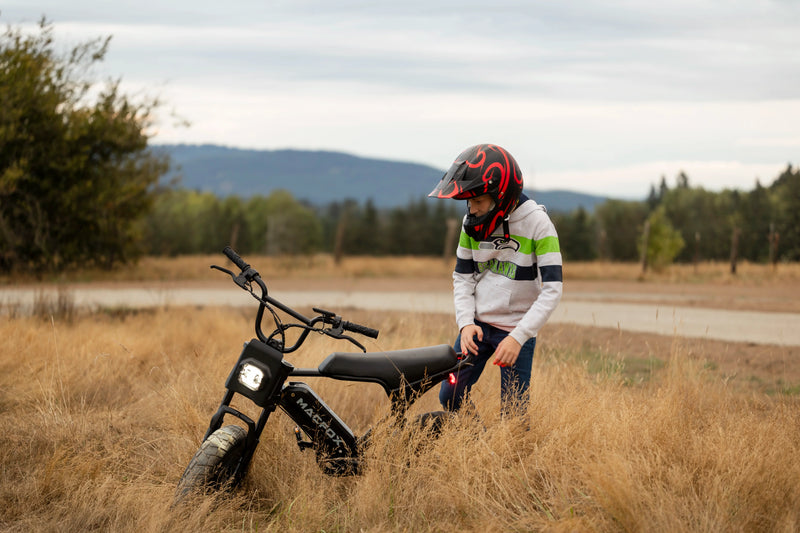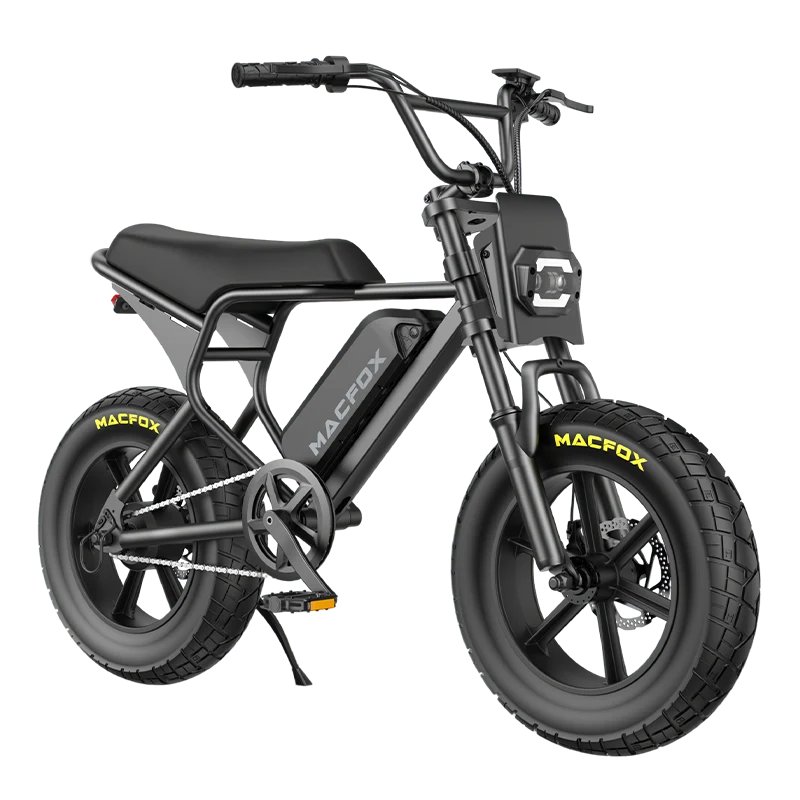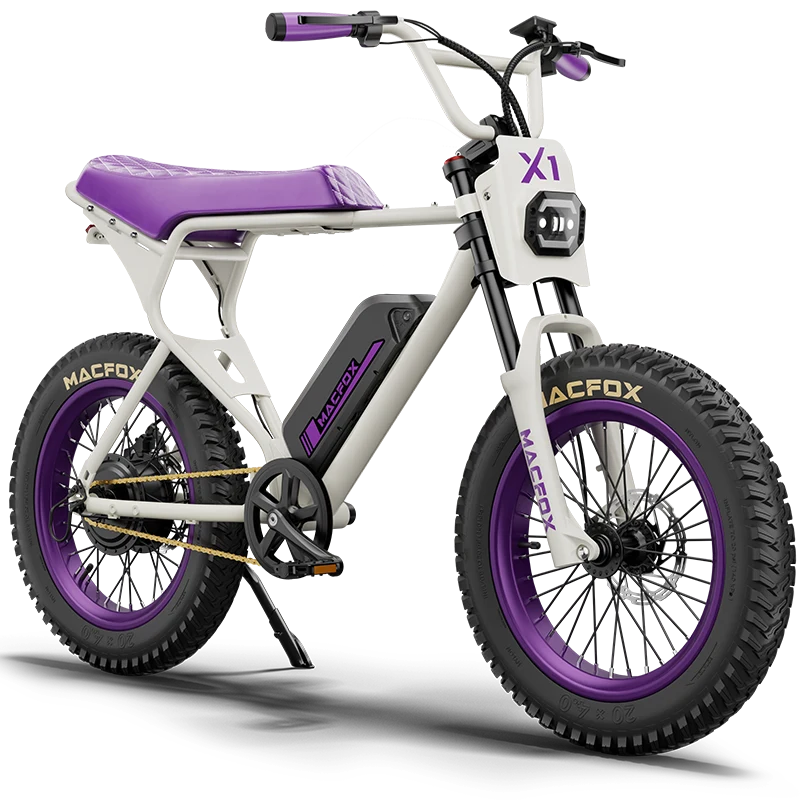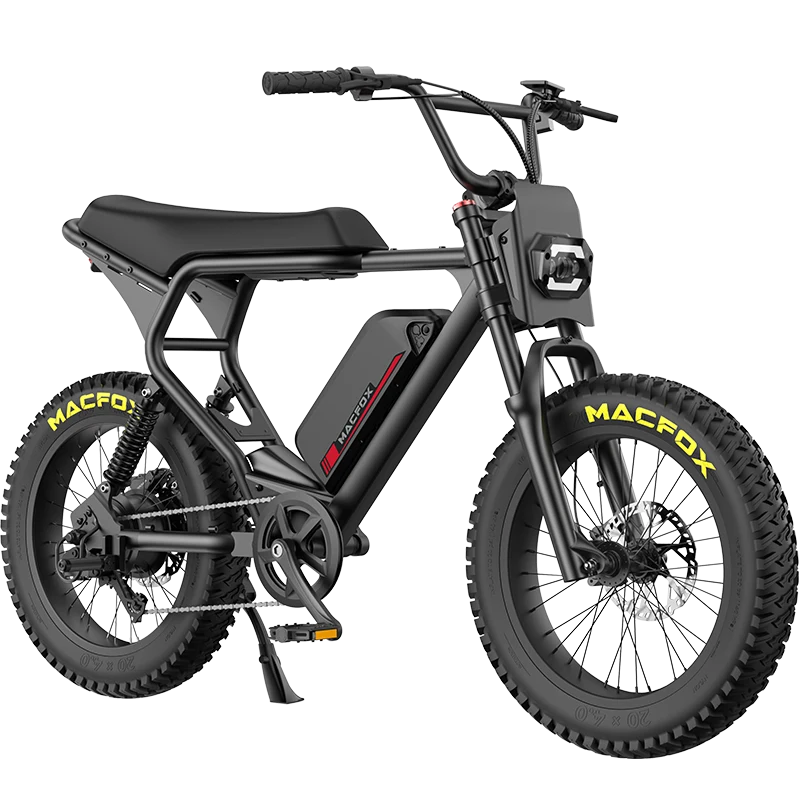The Rise of the Youth Electric Bike
Across the United States, the school commute has been transformed in recent years. Where parents once relied solely on buses, carpools, or long walks, the electric bike has quickly emerged as an appealing option. For teenagers and middle-schoolers alike, a youth electric bike represents independence, convenience, and style. For parents, however, one big question remains: Are youth electric bikes truly safe for daily school commutes?
This article breaks down the most common concerns, highlights the safety features built into modern e-bikes, and shares practical tips for families considering the transition from traditional transportation to an electric solution.

Common Concerns Parents Have
When parents first consider letting their child ride an electric bike to school, a few issues naturally come to mind:
Speed and Control
Most modern youth e-bikes, including Class 2 electric bikes such as the Macfox M16, are capped at 20 mph. This limit strikes a balance — it’s fast enough for practical commuting yet slow enough to reduce accident risk compared to Class 3 e-bikes (which can reach 28 mph). Parents worry that an electric motor might encourage reckless riding, but speed governors and reliable throttles help maintain safe control.
Traffic and Visibility
The school commute often involves navigating car traffic, intersections, and crowded neighborhoods. Parents wonder: Will drivers see my child? This concern is valid, which is why high-quality youth e-bikes come equipped with front and rear LED lights, reflectors, and bright displays. Combined with reflective backpacks or clothing, visibility can be dramatically improved.
Reliability and Durability
Parents also worry about mechanical failures. A bike that breaks down mid-commute is both inconvenient and unsafe. Youth e-bikes designed for everyday use feature reinforced frames, sturdy wheels, and dependable braking systems, reducing the chance of breakdowns during school runs.
Features That Make Youth eBikes Safer
Fortunately, many design elements specifically address the above concerns.
Fat Tires for Stability
One of the biggest safety advantages for school-age riders is the fat tire electric bike. Tires sized 16” × 4.0” or 20” × 4.0” offer increased contact with the road, which improves balance and reduces slips on wet or uneven pavement. For less experienced riders, stability is crucial.
Reliable Disc Brakes
Commuting often involves sudden stops — whether for traffic lights, pedestrians, or other students. Mechanical or hydraulic disc brakes provide consistent stopping power in all conditions, far outperforming rim brakes common on older bicycles. Parents can rest assured that stopping distance is significantly reduced.
Front Suspension for Comfort and Control
School routes aren’t always smooth. Cracked sidewalks, potholes, and curbs can make riding uncomfortable or even hazardous. Youth e-bikes with front fork suspension absorb these bumps, keeping the rider in control and reducing fatigue on longer commutes.
Built-In Safety Compliance
Unlike adult-oriented Class 3 e-bikes, youth-specific models are engineered for compliance. This includes speed caps, integrated lighting systems, and weight-appropriate frames. For example, the Macfox M16 supports riders up to 220 lbs but is sized for teens and pre-teens — ensuring both durability and appropriate ergonomics.
Why Electric Bikes Appeal to Students
It’s not just about safety — young riders have their own reasons for choosing e-bikes for school.
-
Independence: Riding an electric bike allows students to leave home on their own schedule, avoiding the constraints of buses or carpools.
-
Style: A fat tire e-bike isn’t just transportation; it’s part of a teen’s identity. The rugged look and digital LCD displays feel modern and “cool.”
-
Energy Balance: Pedal-assist and throttle options mean riders don’t arrive sweaty or exhausted, even if they live miles away from school.
-
Social Factor: Students often commute with friends, making the journey itself a part of their social life.
Why Parents Can Trust the Commute
For parents, the question is less about fun and more about safety, legality, and value.
-
Speed Control: With a top speed of 20 mph, Class 2 youth e-bikes keep riders within legal and manageable limits.
-
Visibility: Integrated LED headlight and taillight ensure children remain visible in early morning or late afternoon commutes.
-
Durability: High-carbon steel frames and reinforced rear wheels withstand daily use, curbs, and the occasional jump without constant repairs.
-
Cost Efficiency: At under $1,000, the Macfox M16 delivers premium features at nearly half the cost of adult-oriented fat tire models like Super73.

Practical Tips for Parents
Even with the right equipment, safety also depends on preparation. Parents can take proactive steps to maximize safe commutes:
Proper Gear
-
Helmet (mandatory in many states)
-
Reflective backpack covers or straps
-
Gloves for better grip and protection
-
Optional knee/elbow pads for new riders
Route Planning
-
Choose low-traffic side streets whenever possible
-
Scout the route together before the first solo ride
-
Identify safe bike parking near school entrances
Maintenance Habits
-
Check tire pressure weekly for stability
-
Inspect brakes regularly
-
Recharge the battery in a safe indoor location
Real-World Scenario: The 15-Minute School Commute
Imagine a 14-year-old student living 3 miles from school. Walking takes nearly an hour, while the school bus requires a 6:45 a.m. pickup. With a youth electric bike, the same commute becomes a 15-minute ride. The fat tires handle sidewalks and curbs, disc brakes make crossings safe, and the capped speed keeps travel controlled. Parents save time, the teen gains independence, and everyone arrives on schedule.
The Fat Tire Advantage in Daily Commutes
Compared to narrow-tire bicycles, fat tire electric bikes offer unique benefits:
-
Stability on varied terrain: Grass, gravel, wet pavement
-
Shock absorption: Reduced risk of losing control on potholes
-
Confidence for new riders: Wider tires make balance easier, especially for younger or shorter teens
These features directly support safe daily commuting, addressing the exact concerns parents raise.

FAQ: Common Questions About Youth eBike Commutes
Q1: How fast can a youth electric bike go? Most are capped at 20 mph (Class 2), making them both legal and manageable for school commuting.
Q2: Do students need a license? In most U.S. states, Class 2 e-bikes require no license or registration, though helmets are mandatory for riders under 18.
Q3: How long does the battery last? Models like the Macfox M16 provide up to 25 miles per charge, more than enough for daily school trips plus after-school activities.
Q4: Can youth e-bikes handle rain or snow? Yes, within reason. Fat tires improve traction, but parents should set clear rules for severe weather.
Q5: Is it worth the cost compared to a regular bike? Yes — youth e-bikes encourage consistent riding, reduce reliance on cars or buses, and last several years with proper maintenance.
Balancing Safety and Independence
So, are youth electric bikes safe for daily school commutes? The answer is yes — when families choose the right model and establish proper safety practices. With capped speeds, fat tire stability, disc brakes, and LED visibility, today’s youth e-bikes combine excitement for students with peace of mind for parents.
For families seeking a safe, reliable, and stylish way to upgrade the daily school commute, the Macfox M16 represents the ideal solution: purpose-built for youth, compliant with U.S. Class 2 laws, and priced for value.
Ready to give your child independence while ensuring safety?
Explore the Macfox M16 Youth Electric Bike and see why it’s the smart choice for school commutes.


















